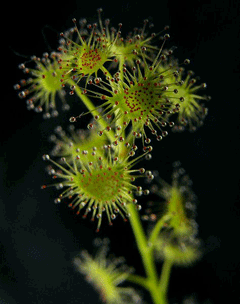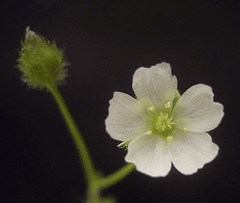 |
|
http://www.darwiniana.cz/vamr/?page=slovnik&id=54 |
 |
| http://commons.wikimedia.org/wiki/User:Denis_Barthel |
Translate this page:
Summary
Physical Characteristics

 Drosera peltata is an evergreen Annual/Perennial growing to 0.3 m (1ft).
Drosera peltata is an evergreen Annual/Perennial growing to 0.3 m (1ft).
See above for USDA hardiness. It is hardy to UK zone 9. It is in leaf all year. The species is hermaphrodite (has both male and female organs).
Suitable for: light (sandy) and medium (loamy) soils and can grow in nutritionally poor soil. Suitable pH: mildly acid, neutral and basic (mildly alkaline) soils and can grow in very acid soils.
It cannot grow in the shade. It prefers moist or wet soil.
UK Hardiness Map
US Hardiness Map
Synonyms
Plant Habitats
Bog Garden; Cultivated Beds;
Edible Uses
References More on Edible Uses
Medicinal Uses
Plants For A Future can not take any responsibility for any adverse effects from the use of plants. Always seek advice from a professional before using a plant medicinally.
Alterative Anodyne Blood tonic Carminative Rubefacient VD
The plant is anodyne, blood tonic and carminative[147]. It is used in India in making gold bhasma, which is antisyphilitic, alterative and tonic[240]. The crushed leaves, with or without salt, have been used as a blistering agent[240]. This can be of value as a poultice since it brings more blood to the area and helps speed the clearance of toxins in arthritis and rheumatism[254].
References More on Medicinal Uses
The Bookshop: Edible Plant Books
Our Latest books on Perennial Plants For Food Forests and Permaculture Gardens in paperback or digital formats.

Edible Tropical Plants
Food Forest Plants for Hotter Conditions: 250+ Plants For Tropical Food Forests & Permaculture Gardens.
More

Edible Temperate Plants
Plants for Your Food Forest: 500 Plants for Temperate Food Forests & Permaculture Gardens.
More

More Books
PFAF have eight books available in paperback and digital formats. Browse the shop for more information.
Shop Now
Other Uses
References More on Other Uses
Cultivation details
Prefers a sandy peaty soil, succeeding in poor soils and in bogs[200]. An insectivorous plant, it can survive in nitrogen poor soils because it gets the nutrients it needs from insects[1, 200]. The upper surfaces of leaves are covered with hairs that secrete a sweet sticky substance[7].This attracts insects, which become smeared with it and unable to escape - the plant then exudes a digestive fluid that enables it to absorb most of the insect into its system[7]. A highly variable species in the wild[266]. This sundew is not very hardy in Britain and is best treated as a greenhouse plant[1].
References Carbon Farming Information and Carbon Sequestration Information
Temperature Converter
Type a value in the Celsius field to convert the value to Fahrenheit:
Fahrenheit:
The PFAF Bookshop
Plants For A Future have a number of books available in paperback and digital form. Book titles include Edible Plants, Edible Perennials, Edible Trees,Edible Shrubs, Woodland Gardening, and Temperate Food Forest Plants. Our new book is Food Forest Plants For Hotter Conditions (Tropical and Sub-Tropical).
Shop Now
Plant Propagation
Seed - best sown as soon as it is ripe in a free-draining soil with some charcoal added and with a layer of finely chopped sphagnum moss on top[175]. Surface sow and keep the compost moist. The seed usually germinates in 1 - 2 months at 20°c[175]. When they are large enough to handle, prick the seedlings out into individual pots and grow them on in the greenhouse for at least their first winter. Plant them out into their permanent positions in late spring or early summer, after the last expected frosts.
Other Names
If available other names are mentioned here
Native Range
TEMPERATE ASIA: China (Anhui Sheng, Gansu Sheng, Guangdong Sheng, Guangxi Zhuangzu Zizhiqu, Guizhou Sheng (west), Hubei Sheng, Hunan Sheng, Jiangxi Sheng, Sichuan Sheng (southwest), Xizang Zizhiqu (south), Yunnan Sheng, Zhejiang Sheng), Japan (Honshu, Kyushu, Shikoku), Taiwan TROPICAL ASIA: India, Sri Lanka, Thailand, Indonesia, Philippines AUSTRALASIA: Australia (Tasmania, New South Wales, Queensland, South Australia (south), Victoria, Western Australia (south), Northern Territory (north))
Weed Potential
Right plant wrong place. We are currently updating this section.
Please note that a plant may be invasive in one area but may not in your area so it's worth checking.
Conservation Status
IUCN Red List of Threatened Plants Status :

Growth: S = slow M = medium F = fast. Soil: L = light (sandy) M = medium H = heavy (clay). pH: A = acid N = neutral B = basic (alkaline). Shade: F = full shade S = semi-shade N = no shade. Moisture: D = dry M = Moist We = wet Wa = water.
Now available:
Food Forest Plants for Mediterranean Conditions
350+ Perennial Plants For Mediterranean and Drier Food Forests and Permaculture Gardens.
[Paperback and eBook]
This is the third in Plants For A Future's series of plant guides for food forests tailored to
specific climate zones. Following volumes on temperate and tropical ecosystems, this book focuses
on species suited to Mediterranean conditions—regions with hot, dry summers and cool, wet winters,
often facing the added challenge of climate change.
Read More
Expert comment
Author
Sm.
Botanical References
58200266
Links / References
For a list of references used on this page please go here
Readers comment
| Add a comment |
|
If you have important information about this plant that may help other users please add a comment or link below. Only comments or links that are felt to be directly relevant to a plant will be included. If you think a comment/link or information contained on this page is inaccurate or misleading we would welcome your feedback at [email protected]. If you have questions about a plant please use the Forum on this website as we do not have the resources to answer questions ourselves.
* Please note: the comments by website users are not necessarily those held by PFAF and may give misleading or inaccurate information.
To leave a comment please Register or login here All comments need to be approved so will not appear immediately.
|
Subject : Drosera peltata
|
|
|
|